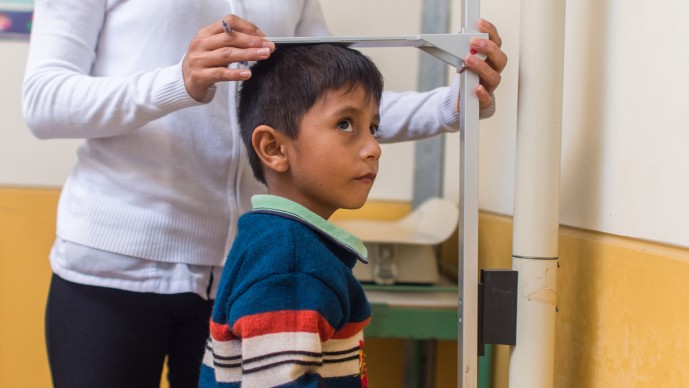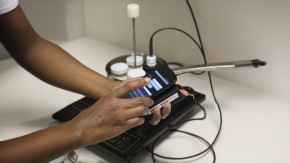
In many areas of health, centuries of scientific discoveries mean that we know a lot. When it comes to gut health, though, we're a little behind. In fact, it wasn't until this century that scientists started talking widely about the gut microbiome - an entire "organ" few people were fully aware we have. That means the territory of gut health is wide open, and some of the most exciting work being done today is exploring this new frontier. Dr. Phillip Tarr is one of the explorers, and what he's discovered may help us treat a lot of sick and malnourished children in poor countries a lot more effectively.
The human gut contains, along with the stomach and the intestine, hundreds of square feet of intestinal lining - enough to cover the floor of a small apartment. In a healthy person, the cells of that lining allow water, ions, and nutrients to pass through into the blood, but the spaces between them are sealed tightly enough to make sure that these are the only things that get out. On the other hand, in a person with increased intestinal permeability, often referred to as a leaky gut, those seals break down, which can allow things like toxins, bacteria, and food particles to leak through the intestinal lining into the blood. The leakier the gut, the more passes through, and those dangerous substances can then get into the blood stream, where they can have serious effects on children's health and development.
In rich countries, leaky gut is most often a problem (and a target for treatment) in relatively specific conditions like Crohn's disease and celiac disease. In poor countries, though, where hundreds of millions of children suffer from malnutrition and intestinal disease associated with poor sanitation, it's a much bigger and more consequential problem. Malnutrition and gut disease are both strongly associated with a dangerous condition called stunting, in which kids' bodies and brains aren't developing the way they should be. We don't have incontrovertible proof that leaky gut causes stunting - just as we don't have incontrovertible proof that smoking causes cancer - but researchers in the field believe that it does, and that it's worth measuring as a proxy.
Up until now, though, there's been only one way to measure leaky gut in humans: drink a solution with a sugar in it that's too large to pass through a healthy intestinal lining, wait several hours, and then measure how much of the sugar appears in the urine (sometimes a sugar small enough to pass through a healthy lining is also included for comparison). The leakier the gut, the more of the large sugar will pass through.
But there are a lot of drawbacks to this test. People disagree on exactly how many hours' worth of urine you need to collect - some say one hour, some say six. The urine has to be preserved incredibly quickly so that bacteria don't start to eat up the sugars you're trying to measure. And, perhaps most problematic for poor countries, there are very few labs in the world that analyze the urine for these sugars really well - and they take weeks to do it. Add it all up, and the only test we have for leaky gut is both imprecise and impractical in a lot of the countries where the problems it causes are most serious.
Or at least that was the only test we had. Dr. Tarr, a pediatric gastroenterologist at Washington University in St. Louis School of Medicine, who also trained in infectious diseases and microbiology, was struck by the fact that the difficulties in testing for leaky gut weren't related to the physiology of the condition, as is the case for many disorders. Instead, the problems were based in the technology available to us. He started to wonder about a test that would allow healthcare workers to give kids something to drink and measure right away how much of it got into the blood stream, without having to take any blood or urine samples at all.
In the meantime, he found out about a company called MediBeacon - also located in St. Louis, as luck would have it - which was developing a kidney-function test using chemical compounds called fluorophores, which can be detected and measured easily through the skin. Together, he and MediBeacon's Dr. Rick Dorshow began to explore how to use fluorophores to test for leaky gut, too.
They brought that question to us in 2013; with a Grand Challenges Explorations (GCE) grant to find new tools in the treatment of intestinal dysfunction, they started working to find an answer. What they found, working with rats as an experiment model, was that fluorophores didn't just work - they actually worked better than sugars. The sugar test is good at telling you whether or not somebody has a leaky gut. Fluorophores are, too, but they do a better job than sugars of telling you just how leaky it is.
Dr. Tarr and Dr. Dorshow then won a follow-on GCE grant to make the fluorophores as easily measurable as possible, perform preclinical toxicity studies, and human trials are expected to start very soon. If all goes well, then before too long healthcare workers in poor countries will be able to give kids a drink, wait a couple minutes, and use an inexpensive skin sensor to find out instantly both whether or not and just how leaky their gut is.
This new tool might provide a way forward in one of the biggest challenges in the field of childhood stunting. Currently, if healthcare workers think children might be at risk of stunting, they can treat them in various ways, but they can't know whether the treatment is succeeding until they can measure changes in their rate of growth, which can take half a year or more. If children are found to have a leaky gut, though, they could be treated for just a month and then tested again - at which point healthcare workers would already know whether their treatment was working or whether they needed to find a different or additional intervention.
We know that hundreds of millions of children around the world are stunted and that many, perhaps most, have a leaky gut. We believe the leaky gut causes the stunting. What we don't fully understand is how to diagnose a leaky gut, treat it, or reverse its effects. The fluorophore-based test for leaky gut is only a beginning - but by putting us in a position to learn a lot more, a lot more accurately, about what's going on in children's guts, it could get us a lot closer to solving the problem.



